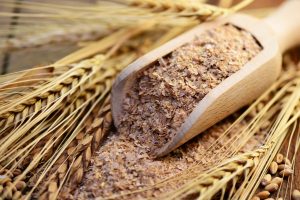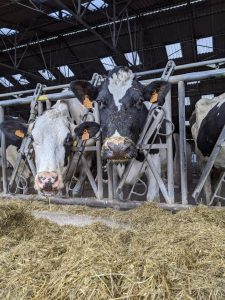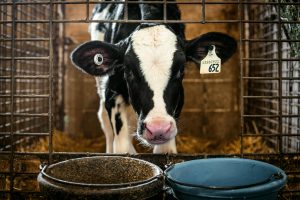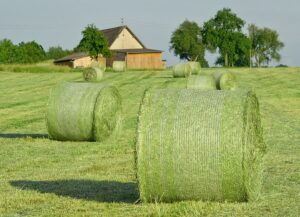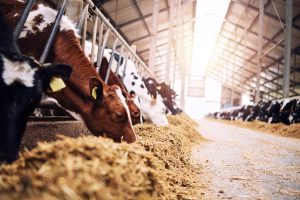Álvaro García
Lameness in dairy cattle, as defined by USDA’s APHIS, is a multifactorial condition impacting about 24% of U.S. dairy cows, with larger herds seeing a higher prevalence and around 55% of herds having at least one lame cow. This condition, stemming from any pain or discomfort affecting the animal’s ability to walk normally, emphasizes the need for comprehensive management to enhance welfare and productivity. Typically, lameness alters gait, with cows showing uneven strides, limb favoring, stiffness, or reluctance to move. The five-point gait scoring system rates severity, from a score of 1, indicating no issues, up to 5 where marked back arching, limb favoring, and reluctance to move or rise are seen. Other issues, such as hip, spine, or muscle strains, can also cause discomfort that resembles limb-based lameness. Prolonged calving, for example, can pressure the pelvic nerves—particularly the obturator and sciatic—leading to impaired movement. These cases often require supportive care, physical therapy, or anti-inflammatories, though nerve recovery can be slow. Proper veterinary diagnosis is essential to determine the source of pain and guide appropriate treatment and management approaches.
Consequences of lameness
Lameness in cows has unintended consequences that affect both the individual cow and herd dynamics, often compounding the issue (Garcia. 2024). Lame cows experience reduced mobility and pain, leading to altered behaviors like decreased feeding time, lower dry matter intake, and fewer visits to the feed bunk. They spend more time lying down to relieve pressure on affected limbs, which can limit access to resources and impact milk yield.
Socially, lame cows tend to isolate from the herd, often relegated to the periphery, engaging less in social or grooming behaviors. This isolation makes them more vulnerable to displacement by healthier, more dominant cows, particularly around feed and resting areas. The reduced social interaction underscores the broader impact of lameness on herd dynamics and social well-being.
Reduced mobility and altered behavior in lame cows often result in lower body condition scores over time. Lame cows avoid competition at the feed bunk, leading to decreased intake, a negative energy balance, and eventual weight loss. This decline in body reserves can hinder recovery from lameness, as reduced nutrient availability impairs tissue repair and immune function.
Risks of the binary scoring system
Scoring lameness on a 1-5 scale can be subjective and complex, even for trained evaluators, leading experts to recommend a simpler binary system—“lame” or “not lame”—to improve consistency and reduce scoring variability. Studies, including Leach et al. (2012), support this approach, finding that a binary system may increase accuracy and consistency in farm environments. Leach et al. (2010) however, noted that a binary approach could miss early signs, increasing severity and extending recovery time. Early identification of subtle gait changes allows for timely intervention, which improves recovery outcomes and reduces treatment needs. For example.
Flower and Weary (2006) suggest that in freestall barns, the scoring system in use is the 5-point gait scoring system, where a score above 2 indicates lameness. Gibbons et al. (2014) suggest that in tiestall barns, it is more prevalent to use behavioral cues, such as weight shifting. While both methods identify moderate to severe lameness, the in-stall approach may miss mild cases, delaying detection. Additionally, UK studies often use a simpler 4-point scale, defining lameness as any score above 1 (Main et al., 2012). A challenge with these scoring systems is their subjective nature, impacting consistency and reliability among different observers, particularly if they lack experience. Advances in 3D-camera technology show promise for automated lameness detection (van Hertem et al. 2014). In that study computer vision algorithms used to classify lameness achieved 81.2% accuracy with a strict binary approach and 90.9% when allowing for a one-unit error on the 5-point scale. By using continuous 3D measurements, the system improved accuracy over traditional visual assessments.
Injuries to the extremities
Injuries to the extremities in cattle can be in the proximal (top), mid-section, and distal (bottom) regions, which is useful for diagnosis and treatment.
- Proximal: This area includes the upper leg near the hip or shoulder. Injuries here may involve large muscle groups, the hip or shoulder joint, or the femur/humerus. Common issues in this region include hip dislocations, muscle strains, or joint injuries, often from slipping or other traumatic incidents.
- Mid-section: It includes the upper portion of the leg below the hip or shoulder and above the knee or hock, encompassing major bones like the femur or humerus. Injuries here, such as fractures or tendon strains, are severe as they impact the cow’s primary weight-bearing areas, often resulting from falls or direct trauma. According to Roche et al. (2023) The most common method for classifying knee and hock injuries employs a 4-point scale, with a score above 1 indicating an injury. Injury prevalence within herds varies widely, with hock injuries affecting 0% to 81.2% of cows, and knee injuries 2.8% to 43%.
- Distal: This region covers the lower leg, including areas around the fetlock, pastern, and hoof. Distal injuries are the most common in dairy cows due to the stresses on their hooves from standing on hard surfaces. Hoof lesions, sole ulcers, or infections like foot rot are frequent here, and these injuries can often lead to lameness. The lower leg is also susceptible to ligament strains and joint inflammation, especially in high-production environments where cows spend extended periods standing. In dairy cattle, studies indicate that 80% to 90% of lameness cases are due to issues in the distal limb, particularly the hooves (ICAR. 2018). This high percentage underscores the importance of regular hoof care and monitoring to maintain cattle health and productivity.
Lameness in dairy cows arises from both traumatic and infectious causes, with specific conditions contributing to its prevalence. Traumatic conditions often result from mechanical stress, environmental factors, and prolonged pressure on the hoof or sole, leading to tissue damage and ulceration. When categorizing lameness based on these incidence rates, approximately 69% of lameness cases are traumatic in origin, while around 31% result from infectious agents. Understanding the relative contributions of traumatic and infectious causes to lameness helps guide prevention and management strategies, highlighting the need for tailored approaches depending on the predominant types of lameness within a herd.
Predisposing and Determinant Factors for Lameness
Environmental conditions significantly impact dairy cows’ susceptibility to lameness, with factors like moisture, slippery surfaces, uneven flooring, and manure accumulation in facilities creating ideal conditions for hoof issues. Moisture in freestall barns or walkways softens hoof tissue, making it more prone to injury and infection. Studies indicate that hooves absorb considerable moisture within minutes of exposure, heightening their vulnerability. Drier conditions in high-traffic areas can reduce this initial risk of hoof degradation.
Slippery surfaces in barns or parlors increase the risk of slips and falls, leading to strained hooves and joints. Adding grooves to floors improves traction, reducing slipping incidents. Uneven surfaces create pressure points on hooves, causing inflammation, while manure buildup adds both moisture and bacteria, raising infection risks.
Beyond susceptibility, some factors directly lead to lameness by worsening hoof conditions. Softened hooves in persistently wet environments are prone to lesions like sole ulcers and white line disease. Uneven floors combined with prolonged standing strain specific hoof areas, causing bruising and ulcers. Accumulated manure fosters bacterial growth, causing infectious lameness like digital dermatitis. Regular facility maintenance is essential to reduce these risks, thereby supporting cow welfare and productivity.
Lameness in dairy cattle is a complex condition influenced by multiple factors, including environmental conditions, management practices, and inherent cow physiology. With an estimated 24% of U.S. dairy cows affected, lameness presents significant challenges to both animal well-being and farm productivity. The prevalence is even higher in large herds, underscoring the need for effective and accessible detection and management strategies.
While simplified scoring systems offer ease for on-farm detection, they may overlook subtle early-stage lameness cases. Studies have demonstrated that early intervention significantly improves recovery outcomes, advocating for more precise assessment methods when possible. Advances in 3D imaging technology and automated monitoring systems provide promising avenues for enhancing detection accuracy and enabling timely interventions, reducing both the economic burden and welfare impacts associated with lameness.
© 2025 Dellait Knowledge Center. All Rights Reserved.



